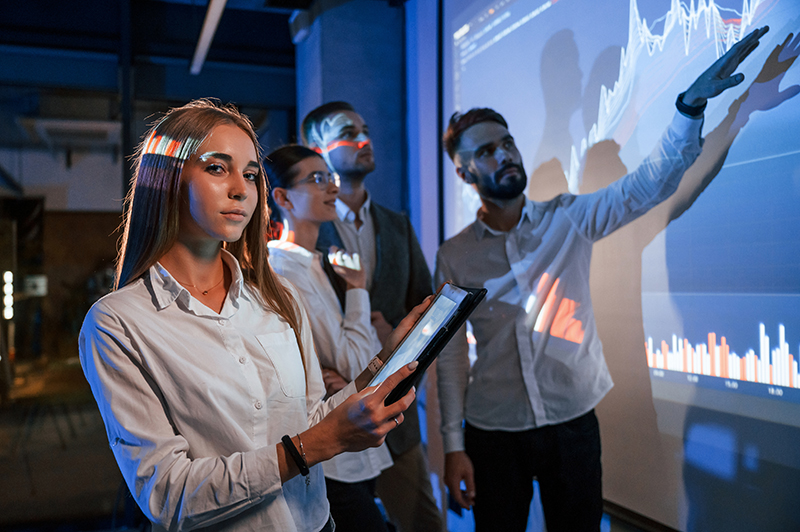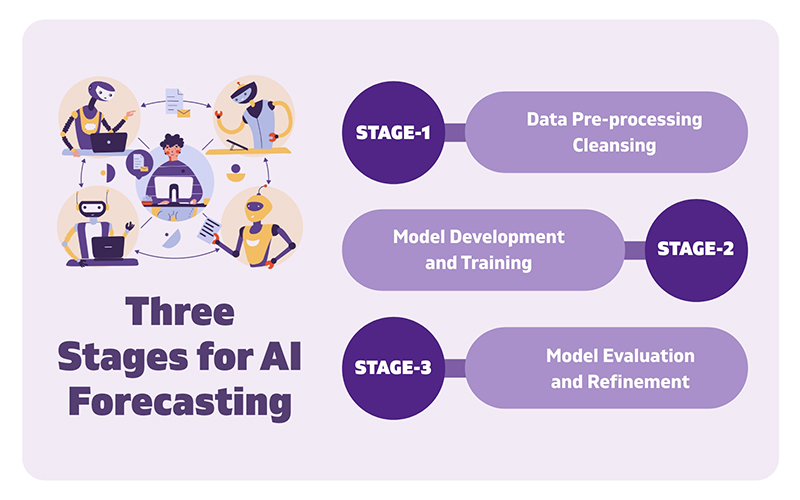Today’s businesses run on data, and to stay competitive and achieve growth at a faster pace, understanding and analyzing only historical data to assess performance and for gaining insights would not suffice. There is a need for continuous learning along with being able to predict future outcomes, and perform based on forecast matrix for businesses to stay on top of competition. This is where AI forecasting models come into play.
Traditional forecasting methods make use of statistical and mathematical models to predict future outcomes. However useful these models used to be, they don’t hold strong while dealing with dynamic and complex data.
On the other hand, AI forecasting models, which make use of the immense power of AI along with machine learning (ML), natural language processing (NLP) and deep learning based on artificial neural networks, can not only analyze and learn from historical data but also produce actionable business forecasting models, which would enable enterprises to anticipate future outcomes and take proactive actions.
What Is AI Forecasting?
Given that every business churns out vast amounts of data year-on-year, it is not easy to sift out relevant data for analysis, and take decisions based on that. However, AI planning and forecasting can help enterprises navigate through volatile markets, understand changing consumer preferences and anticipate future outcomes, or even respond to unforeseen global events.
For example, when the world was hit by the COVID-19 pandemic, businesses across the globe faced unprecedented disruptions, especially those that relied on supply chain networks, as normal business operations were no longer feasible due to heavy restrictions in the movement of goods.
A report by McKinsey says that 93% of their respondents said they changed their company’s supply chain strategy. They had to do it swiftly, as losses kept mounting, and without the power of AI, it would not have been possible. This emphasizes the need for businesses to stay agile and adaptable. Another report by Accenture says 57% of their respondents listed AI as their top priority when it comes to business strategy. It’s the technology that endows tech leaders to not only endure but thrive in today’s ever-evolving business scenario.
And under the umbrella of AI, AI planning and forecasting are two critical divisions that help companies to make decisive decisions in this complex, data-rich environment. While AI planning focuses on defining a sequence of actions to reach specific goals, AI forecasting uses historical data to predict future outcomes. A strategy of combining the two not only helps businesses, but also governments and systems to operate more efficiently, respond to uncertainty, and make proactive, data-driven decisions.
How AI Forecasting Models Help Businesses Predict Future Trends
As mentioned before, the underlying technologies involved in AI forecasting are machine learning, deep learning, NLP and more.
While ML algorithms enable AI systems to learn from data, recognize patterns, and build predictive models, deep learning relies on neural networks to process and analyze vast amounts of data to detect complex patterns and produce tailor-made results.
For example, financial institutions employ machine learning tools to forecast the credit worthiness of an applicant based on the analysis of historical financial data of that person like past current loans to repay, loan repayment history, defaults, and others.
A good example of deep learning would be how Facebook uses AI forecasting algorithms to determine which posts and advertisements to display on a user’s news feed, making the user experience more personal.
For a simpler understanding, let us assign three stages for AI forecasting: Data Pre-processing and Cleansing, Model Development and Training, and Model Evaluation and Refinement.
- Data Pre-processing and Cleansing
Since data comes from various sources, it is essential to ready (pre-process) the data and clean it for inconsistencies, duplicate entries and other anomalies, before being submitted for analysis. The data thus pre-processed is then transformed into logical structure fit for model input.
- Model Training and Development
Upon receiving the right input for a model, it must then be developed and trained. Selecting the appropriate algorithm and feeding it with the prepared data are the steps involved at this stage. For example, Amazon uses different ML algorithms to forecast product demand, while Apple uses recurrent neural networks (RNNs) to train its Siri voice assistant. The latter is a more complex process of training as it uses vast amounts of voice data to recognize command patterns accurately.
- Model Evaluation and Refinement
The process of AI forecasting doesn’t end with developing models. To maintain and ensure forecasting accuracy and relevance, regular data audits, continuous evaluation of results, and periodic refinement of models need to be done. For instance, Netflix employs evaluation metrics like Mean Absolute Error (MAE) and Root Mean Square Error (RMSE) to assess and enhance its content recommendation algorithms continually. Likewise, Google considers real-time changes on the internet to continually refine its predictive capabilities to provide users with more relevant search results.
AI Techniques for Improving Forecasting Accuracy in Volatile Markets
There are various approaches to AI forecasting depending on data types and prediction requirements. The following are the major approaches to AI forecasting employed by different organizations:
- Regression-based model: These models are mainly used by financial institutions, economic analysis firms and marketing agencies where the relationship between the variables are linear and results can be approximated as such. For example, Google uses this approach to predict the click-through rates (CTRs) of advertisements based on historical data on user behavior, and advertising agencies can make use of this information to make data-driven decisions on ad placements and budgets.
- Deep learning models: Deep learning models make use of neural networks to process vast amounts of complex data and identify intricate patterns. These models are useful while making forecasts in volatile environments. Tesla cars employing neural networks to analyze its real-time sensor to predict road conditions, enable features like adaptive cruise control and lane-keeping assistance is an illustrative example of how deep learning improves accuracy in forecasting models.
- Time series forecasting: These models are the most fundamental approach in AI forecasting and are well-suited in scenarios where the data comes as a temporal component. Basically, this model predicts future outcomes based on historical data. Retail businesses make use of these models to forecast sales volumes.
- Ensemble methods: As the name suggests, these models combine multiple models to enhance forecasting accuracy. Ensemble Kalman Filter (EnKF) used in weather forecasting by organizations like the National Oceanic and Atmospheric Administration (NOAA) is a noteworthy example for ensemble technique. Data from various sources, including satellite imagery and ground sensors, are combined by EnKF to mitigate errors and create a more accurate and reliable weather forecast.
Conclusion
While AI forecasting is a valuable tool that provides accurate predictions and insights, it must be combined with human-judgement, ethical considerations and strategic thinking to draw the best results. Collaboration between human expertise and AI tools can create a synergy that ensures more meaningful and robust solutions.
Thinking about employing AI forecasting in your organization? You can consult with DeepKnit AI’s experts who can guide you through the right process for your business forecasting to achieve the desired results.
Forecast the success of your business with the power of AI.
Let AI algorithms guide your business.
Contact Us for a Demo


